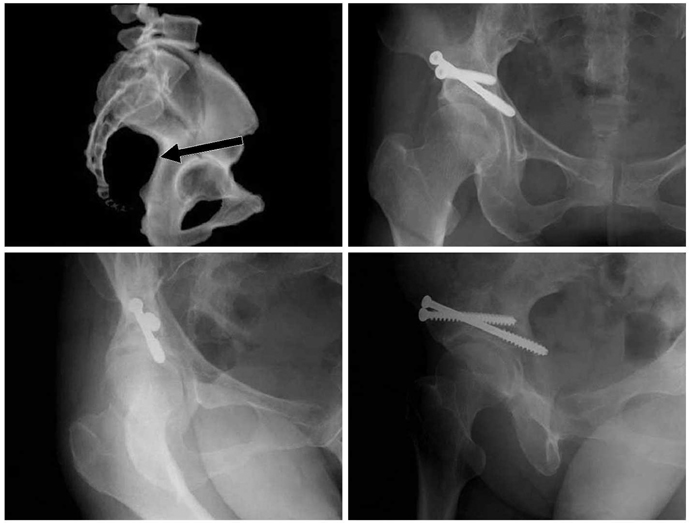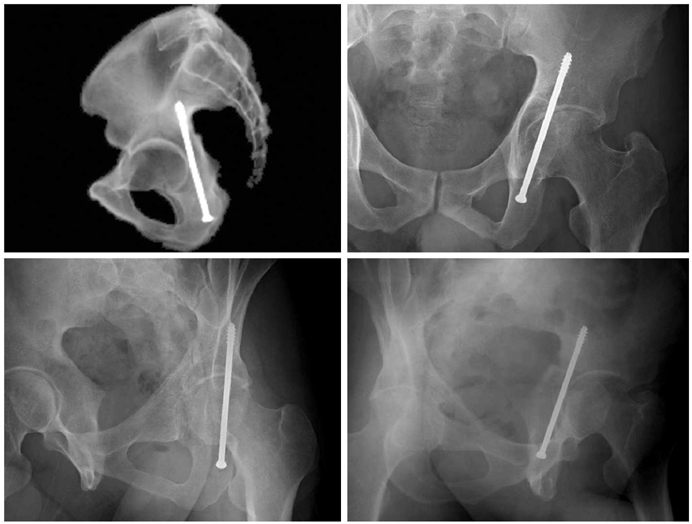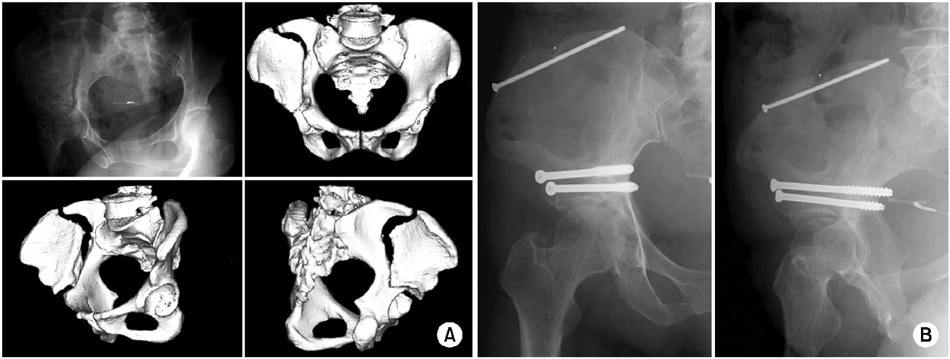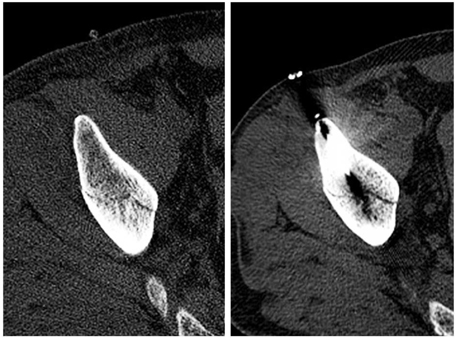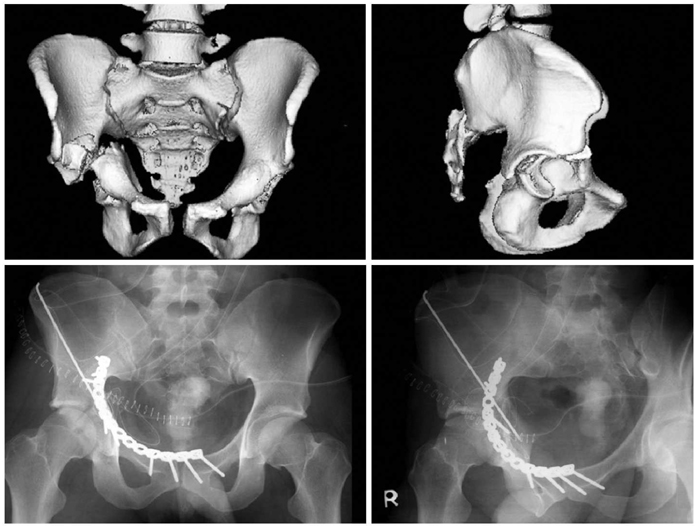J Korean Fract Soc.
2007 Jan;20(1):26-32. 10.12671/jkfs.2007.20.1.26.
Treatment of Acetabular Column Fractures with Limited Open Reduction and Screw Fixation
- Affiliations
-
- 1Department of Orthopedic Surgery, Asan Medical Center, Ulsan University College of Medicine, Seoul, Korea. jjkim2@amc.seoul.kr
- KMID: 2294375
- DOI: http://doi.org/10.12671/jkfs.2007.20.1.26
Abstract
- PURPOSE
To evaluate the results of limited open reduction and screw fixation of acetabular fractures.
MATERIALS AND METHODS
Six acetabular fractures were treated with fluoroscopic guided screw fixation. The mean age was 46 years old and mean follow-up period was 18 months. There were 3 anterior column fractures, 2 transverse fractures and 1 both column fracture. Anterior column screw fixation was used in 5 cases and posterior column fixation in 1 case. Limited ilioinguinal approach was used in 4 cases and percutaneous screw fixation in 2 cases.
RESULTS
The mean union time was 16.6 weeks. The postoperative radiographic results revealed 2 cases with an anatomic reduction and 4 cases with an imperfect reduction. The clinical results showed 1 case with excellent, 4 cases with good and 1 case with fair. Regarding complication, there was 1 case of SI joint penestration without clinical symptoms.
CONCLUSION
Limited open reduction and screw fixation can be a useful alternative treatment for acetabular fractures in patients with minimally displaced fracture, severe multisystem trauma and soft tissue injury not suitable to traditional treatment.
Figure
Reference
-
1. Barnes SN, Stewart MJ. Central fractures of the acetabulum: a critical analysis and review of literature. Clin Orthop Relat Res. 1976; 114:276–281.2. Chang JK, Gill SS, Zura RD, Krause WR, Wang GJ. Comparative strength of three methods of fixation of transverse acetabular fractures. Clin Orthop Relat Res. 2001; 392:433–441.
Article3. Deo SD, Tavares SP, Pandey RK, El-Saied G, Willett KM, Worklock PH. Operative management of acetabular fractures in Oxford. Injury. 2001; 32:581–586.
Article4. Gay SB, Sistrom C, Wang GJ, et al. Percutaneous screw fixation of acetabular fractures with CT guidance: preliminary results of a new technique. AJR Am J Roentgenol. 1992; 158:819–822.
Article5. Heeg M, Oostvogel HJ, Klasen HJ. Conservative treatment of acetabular fractures: the role of the weight-bearing dome and anatomic reduction in the ultimate results. J Trauma. 1987; 27:555–559.6. Kebaish AS, Roy A, Rennie W. Displaced acetabular fractures: long-term follow-up. J Trauma. 1991; 31:1539–1542.7. Kim SK, Park JH, Park JW, Hong JS, Kim JH. Significance of anatomic reduction in acetabular fracture. J Korean Soc Fract. 2000; 13:724–732.
Article8. Letournel E. Acetabulum fractures: classification and management. Clin Orthop Relat Res. 1980; 151:81–106.
Article9. Matta JM. Fractures of the acetabulum: accuracy of reduction and clinical results in patients managed operatively within three weeks after the injury. J Bone Joint Surg Am. 1996; 78:1632–1645.10. Matta JM, Anderson LM, Epstein HC, Hendricks P. Fractures of the acetabulum. A retrospective analysis. Clin Orthop Relat Res. 1986; 205:230–240.11. Matta JM, Letournel E, Browner BD. Surgical management of acetabular fractures. Instr Course Lect. 1986; 35:382–397.12. Matta JM, Mehne DK, Roffi R. Fractures of the acetabulum. Early results of a prospective study. Clin Ortop Relat Res. 1986; 205:241–250.13. Mears DC. Surgical treatment of acetabular fractures in elderly patients with osteoporotic bone. J Am Acad Orthop Surg. 1999; 7:128–141.
Article14. Moed BR, Carr SE, Gruson KI, Watson JT, Craig JG. Computed tomographic assessment of fractures of the posterior wall of the acetabulum after operative treatment. J Bone Joint Surg Am. 2003; 85:512–522.
Article15. Mouhsine E, Garofalo R, Borens O, et al. Percutaneous retrograde screwing for stabilisation of acetabular fractures. Injury. 2005; 36:1330–1336.
Article16. Parker PJ, Copeland C. Percutaneous fluoroscopic screw fixation of acetabular fractures. Injury. 1997; 28:597–600.
Article17. Rockwood G. Fracture of the acetabulum. In : Mark SV, Marrin T, editors. Fracture in adult. 5th ed. Philadelphia: Lippincott Williams & Wilkins;2001. p. 1513–1545.18. Routt ML Jr, Simonian PT, Grujic L. The retrograde medullary superior pubic ramus screw for the treatment of anterior pelvic ring disruptions: a new technique. J Orthop Trauma. 1995; 9:35–44.
Article19. Saterbak AM, Marsh JL, Turbett T, Brandser E. Acetabular fractures classification of Letournel and Judet - a systemic approach. Iowa Orthop J. 1995; 15:184–196.20. Sen M, Harvey EJ, Steinitz D, Guy P, Reindl R. Anatomical risks of using supra-acetabular screws in percutaneous internal fixation of the acetabulum and pelvis. Am J Orthop. 2005; 34:94–96.21. Starr AJ, Jones AL, Reinert CM, Borer DS. Preliminary results and complications following limited open reduction and percutaneous screw fixation of displaced fractures of the acetabulum. Injury. 2001; 32:Suppl 1. SA45–SA50.22. Starr AJ, Reinert CM, Jones AL. Percutaneous fixation of the columns of the acetabulum: a new technique. J Orthop Trauma. 1998; 12:51–58.
Article23. Stockle U, Hoffmann R, Nittinger M, Sudkamp NP, Haas NP. Screw fixation of acetabular fractures. Int Orthop. 2000; 24:143–147.
Article24. Yoon TR, Jung SN, Park SJ, Song EK. Internal fixation with pelvic plate for displaced acetabular fracture. J Korean Soc Fract. 2000; 13:733–740.
Article25. Zura RD, Kahler DM. A transverse acetabular nonunion treated with computer-assisted percutaneous internal fixation. A case report. J Bone Joint Surg Am. 2000; 82:219–224.
Article
- Full Text Links
- Actions
-
Cited
- CITED
-
- Close
- Share
- Similar articles
-
- Single Percutaneous Retrograde Anterior Column Screw Fixation in a Minimally Displaced Transverse Acetabular Fracture - A Case Report -
- Cerclage Wiring in Internal Fixation of Displaced Acetabular Fractures
- Anterior Approach for the Acetabular Fractures
- Surgical Treatment of Displaced Acetabular Fractures
- Treatment of Acetabular Fracture with Wire

